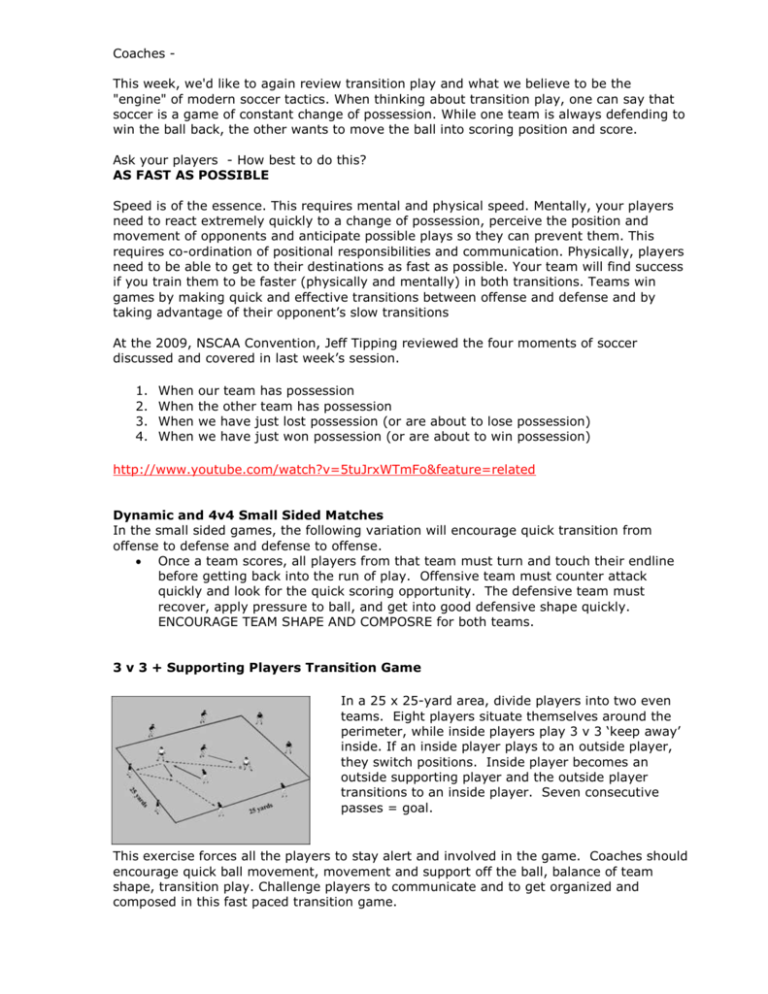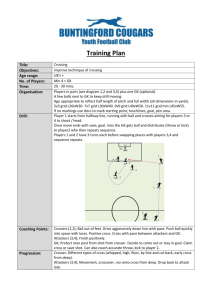6v6 Quick Transition - Far Post Soccer Club
advertisement

Coaches This week, we'd like to again review transition play and what we believe to be the "engine" of modern soccer tactics. When thinking about transition play, one can say that soccer is a game of constant change of possession. While one team is always defending to win the ball back, the other wants to move the ball into scoring position and score. Ask your players - How best to do this? AS FAST AS POSSIBLE Speed is of the essence. This requires mental and physical speed. Mentally, your players need to react extremely quickly to a change of possession, perceive the position and movement of opponents and anticipate possible plays so they can prevent them. This requires co-ordination of positional responsibilities and communication. Physically, players need to be able to get to their destinations as fast as possible. Your team will find success if you train them to be faster (physically and mentally) in both transitions. Teams win games by making quick and effective transitions between offense and defense and by taking advantage of their opponent’s slow transitions At the 2009, NSCAA Convention, Jeff Tipping reviewed the four moments of soccer discussed and covered in last week’s session. 1. 2. 3. 4. When When When When our team has possession the other team has possession we have just lost possession (or are about to lose possession) we have just won possession (or are about to win possession) http://www.youtube.com/watch?v=5tuJrxWTmFo&feature=related Dynamic and 4v4 Small Sided Matches In the small sided games, the following variation will encourage quick transition from offense to defense and defense to offense. Once a team scores, all players from that team must turn and touch their endline before getting back into the run of play. Offensive team must counter attack quickly and look for the quick scoring opportunity. The defensive team must recover, apply pressure to ball, and get into good defensive shape quickly. ENCOURAGE TEAM SHAPE AND COMPOSRE for both teams. 3 v 3 + Supporting Players Transition Game In a 25 x 25-yard area, divide players into two even teams. Eight players situate themselves around the perimeter, while inside players play 3 v 3 ‘keep away’ inside. If an inside player plays to an outside player, they switch positions. Inside player becomes an outside supporting player and the outside player transitions to an inside player. Seven consecutive passes = goal. This exercise forces all the players to stay alert and involved in the game. Coaches should encourage quick ball movement, movement and support off the ball, balance of team shape, transition play. Challenge players to communicate and to get organized and composed in this fast paced transition game. 6v6 Quick Transition Two teams square off in a limited area. The objective is to keep the ball from the other team and score by passing the ball to the goalkeeper’s hands. Team then attempts to possess and play to opposite target (GK). Give restrictions on how many touches and passes before the ball can be passed to the goalkeeper. Coaches need to focus on movement of the ball, movement into space with and without the ball, accuracy in passing and receiving, and quick transition. If you’d like to see the same game online, go to the following link: http://www.insidesoccer.com/page/3b015820-68d5-4efa-813b-23fa77e4064d/end-zonegame.html These transition games help the players develop passing, support play, and receiving skills. Players must play with good awareness and make good decisions on and off the ball. Possession and Transitional Play Use the entire Futsal field. Split the team in half. Goalkeeper in each goal. (Ideal if you can use the bigger goals OR put two Futsal goals together). - Blue team plays possession. Seven passes equals a goal. Possession team may use GK’s as supporting players. - Yellow team plays to either goal. Play 3 minute games. Once teams get into a good rhythm, coach may add the following variation: - When possession team connects seven consecutive passes, team transitions to ‘attacking to goal’ team. Players are challenged to execute at highest speed possible while keeping control and possession of the ball. Anticipation, reaction and decision making speeds are developed.


